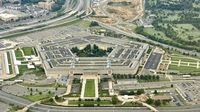Journalists covering the U.S. military are bracing for a pivotal week as new Pentagon rules threaten to upend decades of established access and reporting norms. The updated policy, set to take effect next week, has sparked a fierce debate between the Department of Defense and news organizations, raising questions about press freedom, government transparency, and the very nature of democratic oversight.
At the center of the storm is Secretary of Defense Pete Hegseth, who addressed senior military leaders at Marine Corps Base Quantico on September 30, 2025, just as the controversy was reaching a boiling point. Journalists now face a stark choice: sign a statement acknowledging the new restrictions or risk losing their credentials and access to the Pentagon. The deadline, looming just days away, has set the stage for what many in the media are calling an unprecedented standoff.
The Pentagon Press Association (PPA), representing the journalists who cover the Defense Department, has not minced words. "Negotiations over changing some of the restrictions have not been as successful as we had hoped," the association stated on October 8, 2025, according to the Associated Press. The new rules, they argue, limit where reporters can go within the Pentagon without an official escort and send "an unprecedented message of intimidation" to Defense Department personnel who might consider speaking to the press without prior approval.
It’s not just about physical movement. The initial draft of the policy, released in September, appeared to require Pentagon approval before journalists could publish any information, even if it was unclassified. This caused immediate uproar among news organizations, who saw it as a direct threat to the First Amendment and the public’s right to know how their military is being run. The Pentagon, perhaps sensing the backlash, later clarified that it cannot block journalists from reporting news. However, it maintained that it can revoke credentials from any reporter who seeks information without official authorization.
“We acknowledge and appreciate that the Pentagon is no longer requiring reporters to express agreement with the new policy as a condition for obtaining press credentials,” the PPA noted in a statement. “But the Pentagon is still asking us to affirm in writing our ‘understanding’ of policies that appear designed to stifle a free press and potentially expose us to prosecution for simply doing our jobs.”
The Reporters Committee for Freedom of the Press (RCFP) has also been involved in discussions with the Pentagon. Gabe Rottman, vice president of policy for the RCFP, expressed ongoing concerns, telling multiple outlets, “We still have concerns with the updated language of the policy and expect that it will pose a significant impediment as journalists weigh with their employers whether or not to sign this revised version.”
Another major point of contention is the Pentagon’s plan to move the press corps from their current workspace to an as-yet-unknown location. The PPA was blindsided by this announcement, suggesting that the move would further isolate journalists and make it harder for them to interact even with official spokespeople. “We can surmise from restrictions imposed earlier this year that the changes will further isolate reporters, making it harder to interact even with the spokespeople inside the Pentagon who are entrusted to approve information for public release,” the PPA said, as reported by The Hill.
Historically, Pentagon reporters have operated under the same set of rules since the Eisenhower administration, including during President Donald Trump’s first term. The idea that journalists have been "prowling in offices where they are not allowed is simply preposterous," the association emphasized. “Pentagon reporters have always worn badges, and continue to do so to this day,” the PPA added, responding to new demands for an additional press identifier badge alongside their official credentials.
Secretary Hegseth, for his part, has defended the new guidelines vigorously. In a Fox News interview earlier this month, he stated, “We’re not playing games. We’re not allowing everybody to roam around the building. Yes, you can be in the press area, briefing room, but if you want to move around the building, you’re going to have a badge, it’s going to be cleared, you’re going to be escorted when you do so, and we have expectations that you’re not soliciting classified or sensitive information. I think the American people see things like that as absolute common sense. The Pentagon press corps can squeal all they want.”
But many in the media see it differently. CNN, for example, has vowed to continue its mission to report on the U.S. military "regardless of physical access to the Pentagon." The updated policy, they argue, still leaves open the threat that reporters’ credentials could be revoked if they release information that hasn’t been formally approved for release—even if it’s entirely unclassified. The PPA warned, “The policy conveys an unprecedented message of intimidation to everyone within the DoD, warning against any unapproved interactions with the press and even suggesting it’s criminal to speak without express permission—which plainly, it is not.”
Underlying the current dispute is a broader trend of strained relations between the Trump administration and the press. In January 2025, the Pentagon removed several outlets from their workspaces, replacing them with more conservative-leaning publications. The following month, the Associated Press was excluded from White House events for not following a presidential executive order. President Trump himself has sued multiple media organizations and moved to restrict funding for government-run news services, according to the Associated Press and The Hill.
President Trump, however, appeared to break with the Pentagon on the issue last month, telling The Hill, “Nothing stops reporters.” Still, the administration’s actions have left many journalists wary.
For decades, Pentagon reporters have been restricted to unclassified spaces and have always worn badges. The idea that the new rules are necessary to prevent journalists from accessing sensitive areas simply doesn’t hold water for many in the press. “Let’s be clear about the facts. Pentagon reporters have always worn badges, and continue to do so to this day,” the PPA reiterated. “And reporters have a constitutional right to ask questions.”
The stakes are high. As the Pentagon Press Association put it, “Limiting the media’s ability to report on the U.S. military fails to honor the American families who have entrusted their sons and daughters to serve in it, or the taxpayers responsible for giving the department hundreds of billions of dollars a year. The American people deserve to know how their military is being run.”
As the deadline approaches, the clash between the Pentagon and the press corps shows no signs of abating. Both sides seem dug in, with the Defense Department insisting on tighter controls and journalists warning of an "unprecedented" threat to press freedom. For now, all eyes are on Washington, as reporters weigh whether to sign—and what that decision will mean for the future of military reporting in the United States.





